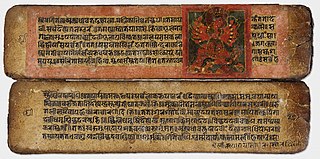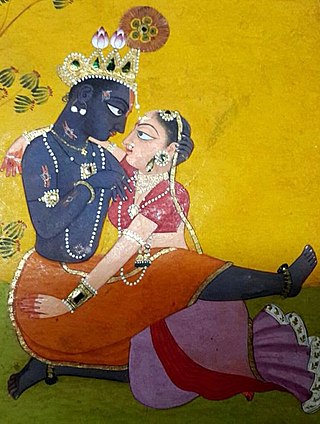
Radha, also called Radhika, is a Hindu goddess and the chief consort of the god Krishna. She is the goddess of love, tenderness, compassion, and devotion. In scriptures, Radha is mentioned as the avatar of Lakshmi and also as the Mūlaprakriti, the Supreme goddess, who is the feminine counterpart and internal potency of Krishna. Radha accompanies Krishna in all his incarnations. Radha's birthday is celebrated every year on the occasion of Radhashtami.

Sanskrit literature broadly comprises all literature in the Sanskrit language. This includes texts composed in the earliest attested descendant of the Proto-Indo-Aryan language known as Vedic Sanskrit, texts in Classical Sanskrit as well as some mixed and non-standard forms of Sanskrit. Literature in the older language begins with the composition of the Ṛg·veda between about 1500 and 1000 BCE, followed by other Vedic works right up to the time of the grammarian Pāṇini around 6th or 4th century BCE.

The Nāṭya Śāstra is a Sanskrit treatise on the performing arts. The text is attributed to sage Bharata, and its first complete compilation is dated to between 200 BCE and 200 CE, but estimates vary between 500 BCE and 500 CE.

Hemachandra was a 12th century Indian Jain saint, scholar, poet, mathematician, philosopher, yogi, grammarian, law theorist, historian, lexicographer, rhetorician, logician, and prosodist. Noted as a prodigy by his contemporaries, he gained the title kalikālasarvajña, "the knower of all knowledge in his times" and father of the Gujarati language.

The Five Great Epics are five Tamil epics according to later Tamil literary tradition. They are Silappatikāram, Manimekalai, Cīvaka Cintāmaṇi, Valayapathi and Kundalakesi.

Purohita Thirunarayanaiyengar Narasimhachar, commonly known as PuTiNa, was a playwright and poet in the Kannada language. Along with, Kuvempu and D. R. Bendre, he forms the well-known trio of Kannada Navodaya poets. He was a Sahitya Akademi fellow and the winner of the Pampa Award, awarded by the Government of Karnataka in 1991.

Telugu literature is the body of works written in the Telugu language. It consists of poems, short stories, novels, plays, and song lyrics, among others. There is some indication that Telugu literature dates at least to the middle of the first millennium, the first extant works are from the 11th century when the Mahabharata was first translated to Telugu from Sanskrit by Nannaya. The language has experienced a golden age under the patronage of the Vijayanagara Emperor-Poet Krishnadevaraya.
In Indian aesthetics, a rasa literally means "juice, essence or taste". It is a concept in Indian arts denoting the aesthetic flavour of any visual, literary or musical work that evokes an emotion or feeling in the reader or audience, but cannot be described. It refers to the emotional flavors/essence crafted into the work by the writer or a performer and relished by a 'sensitive spectator' or sahṛidaya, literally one who "has heart", and can connect to the work with emotion, without dryness.
Maduraikanchi, is an ancient Tamil poem in the Sangam literature. It is a didactic poem and its title connotes the "poetic counsel addressed to the king of Madurai". Composed by Mankuti Marutanar – probably the chief court poet of the Pandya king Nedunjeliyan II, the Maduraikkāñci is the sixth poem in the Pattuppāṭṭu anthology. The poem is generally dated to the late classical period.
The history of Gujarati literature may be traced to 1000 AD, and this literature has flourished since then to the present. It is unique in having almost no patronage from a ruling dynasty, other than its composers.

The Krishna Karnamrita is a Sanskrit devotional work by the poet Vilvamangala of Kerala. Dated between the period of the ninth to the fifteenth century CE, the work eulogises the Hindu deity Krishna.

Kirātārjunīya is an epic poem by Bhāravi, written in Sanskrit. Believed to have been composed in the 6th century or earlier, it consists of eighteen cantos describing the combat between Arjuna and Shiva. Along with the Naiṣadhacarita and the Shishupala Vadha, it is one of the larger three of the six Sanskrit mahakavyas, or great epics. It is noted among Sanskrit critics both for its gravity or depth of meaning, and for its forceful and sometimes playful expression. This includes a canto set aside for demonstrating linguistic feats, similar to constrained writing. Later works of epic poetry followed the model of the Kirātārjunīya.

The Gambler's lament is one of the hymns of the Rigveda which do not have any direct cultic or religious context. It is found in the late Tenth Book, where most of such hymns on "miscellaneous" topics are found, suggesting a date of compilation corresponding to the early Indian Iron Age. The hymn was composed by either Kanvasha Ailusha or Aksha Maujavant.
Doha is a lyrical verse-format which was extensively used by Indian poets and bards of North India probably since the beginning of the 6th century AD. Dohas of Kabir, Tulsidas, Raskhan, Rahim and the dohas of Nanak called Sakhis are famous. Satasai of Hindi poet, Bihārī, contains many dohas. Dohas are written even now.
A subhashita is a literary genre of Sanskrit epigrammatic poems and their message is an aphorism, maxim, advice, fact, truth, lesson or riddle. Su in Sanskrit means good; bhashita means spoken; which together literally means well spoken or eloquent saying.
Vrind (1643–1723) was an Indian saint and poet in Hindi language from Marwar, in present Rajasthan. He was an important poet of the Ritikal period of Hindi literature, known for his poems on ethics (Niti), and most known for his work Nitisatsai (1704), a collection of 700 aphorisms. He was the guru of Raj Singh, ruler of Kishangarh, where he was court poet.

Old Western Rājasthāni is the ancestor of the modern Gujarati and Rajasthani languages which developed from Sanskrit and the Prakrit Apabhraṃśas, and was spoken around 8-14th centuries in Western India. The literary form of Old Western Rājasthāni, the Dingala language was in use as early as the 12th century. While the spoken Old Western Rajasthani gave way to medieval forms of Rajasthani and Gujarati, it flourished in its literary form as Dingala till the 19th century.
Jinaharsha was a Jain ascetic poet who lived in 17th and 18th century.
Rasa or Raso is a certain didactic literary form in Apabhramsa. It is a genre of poetry in Old Gujarati language popular during early period of Gujarati literature. Sometimes the term is used interchangeably with Prabandha of medieval literature.

Kalicharan Pattnaik also known by his sobriquet Kabichandra was an eminent literary and artistic figure of Odisha. He had contributions in the field of Odissi music, Odissi dance and Odia theatre. He had significant contributions to development early Odia cinema as well. He was born on 23 December 1898 in the then princely state of Badamba. His compositions in various traditional ragas are widely sung in the field of Odissi music and dance.













